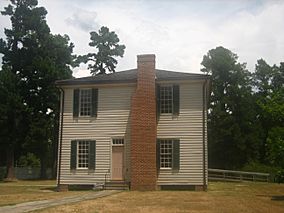Historic Washington State Park facts for kids
Quick facts for kids Historic Washington State Park |
|
|---|---|

The Old State House, Washington, Arkansas
|
|
| Location | Washington, Hempstead County, Arkansas, United States |
| Area | 101 acres (41 ha) |
| Established | July 1, 1973 |
| Governing body | Arkansas Department of Parks and Tourism, Pioneer Washington Preservation Foundation |
| Website | Historic Washington State Park |
Historic Washington State Park is a special place in Hempstead County, Arkansas, covering 101 acres. It's like a living museum where you can step back in time. The park shows what life was like in the 19th century.
This park was once a busy pioneer town called Washington, Arkansas. It was an important stop along the Southwest Trail. Many people traveling to Mexican Texas passed through here.
Today, you can explore 54 historic buildings. These buildings are filled with items from the past. Guided tours help you imagine life long ago.
Washington was also important during the American Civil War. It served as the capital of Arkansas from 1863 to 1865. This happened when Little Rock was not safe. The town's original layout is so historic it was added to the National Register of Historic Places in 1972.
Contents
Discovering Historic Washington
The Southwest Trail and Early Travelers
The Southwest Trail was a major route for pioneers. It stretched from St. Louis, Missouri, all the way to the Red River. This river was the border between the United States and Mexico back then. Many famous people, like William B. Travis, Sam Houston, and Davy Crockett, traveled through Washington on their way to Texas.
A Town's Beginning and Growth
Washington got its first post office on February 14, 1820. This post office is still open today. It is the oldest continuously running postal service west of the Mississippi River. The town officially became a town on February 22, 1824. This date was George Washington's birthday.
Washington During the Civil War
From 1863 to 1865, Washington became the capital of Confederate Arkansas. This happened after Union forces took control of Little Rock. The building where the government met is still in the park. It is part of the Camden Expedition Sites.
Preserving History: The Park's Creation
In 1958, a group called the Pioneer Washington Restoration Foundation started saving the old buildings. The state park officially opened in 1973. Since then, over 200,000 historical items have been found here. Archaeologists continue to study the town's past.
Architecture and Natural Wonders
The park's buildings show different styles from the 1800s. You can see Greek Revival, Federal, and Gothic Revival designs. The streets are still unpaved, with old plank board sidewalks.
A special "Moon tree" was planted here on March 15, 1976. This tree grew from a seed that traveled to the Moon! The largest magnolia tree in Arkansas, planted in 1839, also grows in the town.
Southwest Arkansas Regional Archives
The park is home to the Southwest Arkansas Regional Archives. This is a great place for learning about local history. It has old books, court papers, newspapers, and photos. Many families use it to research their ancestors.
See also



